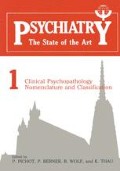Résumé
D’aucuns se demanderont au nom de quelle aberration on a pu confier ce sujet à un clinicien, même s’il est quelque peu mâtiné de biologiste, et plus encore au nom de quoi le clinicien sollicité a pu accepter cette tâche! Bonnes raisons ou non, au sens gidien du terme, on peut en citer plusieurs. La pratique médicale, et mieux encore la pratique psychiatrique permettraient à elles seules de réfuter les théories reçues qui, encore trop souvent, relient génotype et phénotype par une causalité linéaire et univoque. Nombre de spécialistes qui ont le plus contribué à établir la complexité de la construction du phénotype à travers l’interaction du génome et de l’environnement restent, par conventionnalisme ou inertie métaphysique, des champions de ces idées reçues. Ainsi MONOD qui écrit: ... “Ce système, par ses propriétés, par son fonctionnement d’horlogerie microscopique, qui établit entre ADN et protéines, comme aussi entre organisme et milieu, des relations à sens unique, défie toute description dialectique. Il est foncièrement cartésien et non hégélien: la cellule est bien une machine”. LEDER, après avoir montré que les recombinaisons du génome se poursuivent au niveau des lymphocytes B durant toute la vie afin de produire l’énorme diversité des anticorps, conclut qu’elles procèdent du hasard.
Access this chapter
Tax calculation will be finalised at checkout
Purchases are for personal use only
Preview
Unable to display preview. Download preview PDF.
Literature
Baldwin, J.M., 1896, A new factor in evolution, American naturalist, 30, 441–451 et 536-553.
Bertalanffy von, L., 1980, Théorie générale des systèmes, Dunod, Paris, 1 vol., 298 p.
Binding, K. und Hoche, A., 1920, Die Freigabe der Vernichtung lebensunwerten Lebens. Ihr Mass. und irhe Form, Felix Meiner, Leipzig, 1 vol.
Brilloin, L., 1963, Science and information theory, Academic Press, New York, 1 vol., 351 p.
Carroll, B.J., 1982, The dexamethasone suppression test for melancholia, Brit. J. Psychiat., 140, 292–304.
Changeux, J.P., 1983, L’homme neuronal, Fayard, Paris, 1 vol., 419 p.
Chapeville, F. et Ninio, J., 1979, Darwinisme et biologie moléculaire, In: Le darwinisme aujourd’hui, Seuil, Paris, 1 vol., 93–110.
Devillers, C., Blanc, M., 1981, La crise du néo-darwinisme. Recherche, 12, 1154–1156.
Dobzhansky, T., 1969, L’hérédité et la nature humaine, Flammarion, 1 vol. 182 p.
Harlow, H.F. and Harlow, M.K., 1965, The effects of early social deprivation on primates. In: Désafférentation expérimentale et clinique, 2ème Symposium de Bel-Air, Genève, septembre 1964, Georg, Genève et Masson, Paris, 67-77.
Jakobson, R., 1942, Kindersprache, Aphasie und allgemeine Lantgesetze, Uppsala, Uppsala Universitets, Arsskrift, 1 vol. 83 p.
Jakobson, R., 1949, Les lois phoniques du langage enfantin et leur place dans la phonologie générale. In: Troubetzkoy, N., Principes de Phonologie, Klincksieck, Paris, 367-379.
Kuhn, T.S., 1972, La structure des révolutions scientifiques, Flammarion, 1 vol., 246 p.
Leder, P., 1983, Genetic control of immunoglobulin production, Hospital Practise, 18 (2), 73–82.
Lewin, R., 1980, Evolutionary theory under fire. Science, 210, 883–887.
Mendlewicz, J., Charles, G. and Franckson, J.M., 1982, The dexa methasone suppression test in affective disorder: relationship to clinical and genetic subgroups, Brit. J. Psychiat., 141, 464–470.
Monod, J., 1970, Le hasard et la nécessité, Seuil, Paris, 1 vol., 197 p.
Piaget, J., 1974, Adaptation vitale et psychologie de l’intelligence, Hermann, Paris, 1 vol., 109 p.
Piaget, J., 1967, Biologie et connaissance, Gallimard, Paris, 1 vol., 420 p.
Prigogine, I. et Stengers, I., 1979, La nouvelle alliance, Galli mars, Paris, 1 vol., 302 p.
Spitz, R.A., 1945, 1, 1946, 2, Hospitalism: an inquiry into the genesis of psychiatric conditions in early childhood, Psychoanal., Stud. Child, 53-74 et 113-117.
Tissot, R., 1979, Introduction à la psychiatrie biologique, Masson, Paris, 1 vol., 170 p.
Tissot, R., 1974, Thérapeutique médicamenteuse au long cours des psychoses, In: Traitement au long cours des états psychotiques, Privat Ed., Toulouse, 49-100.
Vaughn, C.E. and Leff, J.P., 1976, The influence of family and social factors on the course of psychiatric illness. A comparison of schizophrenic and depressed neurotic patients, Brit. J. Psychiat., 129, 125–137.
Waddington, C.H., 1957, The strategy of the genes, G. Allen and Unwin, LTD, London, 1 vol. 262 p.
Author information
Authors and Affiliations
Editor information
Editors and Affiliations
Rights and permissions
Copyright information
© 1985 Springer Science+Business Media New York
About this chapter
Cite this chapter
René, T. (1985). Genotype, Phenotype et Regulations Epigenetiques. In: Pichot, P., Berner, P., Wolf, R., Thau, K. (eds) Clinical Psychopathology Nomenclature and Classification. Springer, Boston, MA. https://doi.org/10.1007/978-1-4899-5049-9_49
Download citation
DOI: https://doi.org/10.1007/978-1-4899-5049-9_49
Publisher Name: Springer, Boston, MA
Print ISBN: 978-1-4899-5051-2
Online ISBN: 978-1-4899-5049-9
eBook Packages: Springer Book Archive

